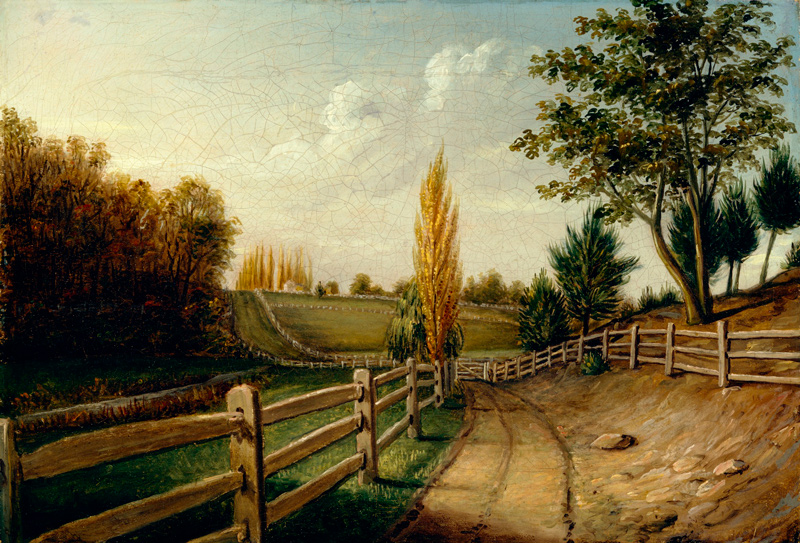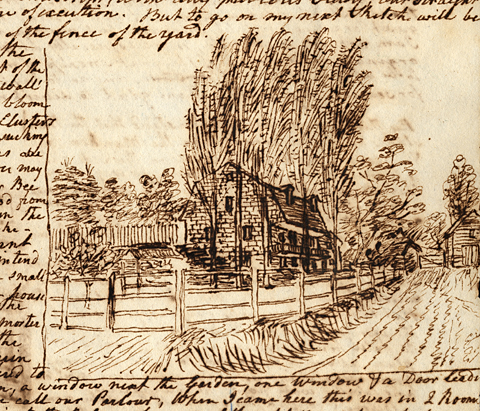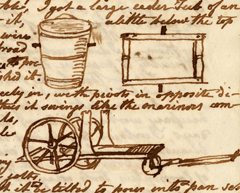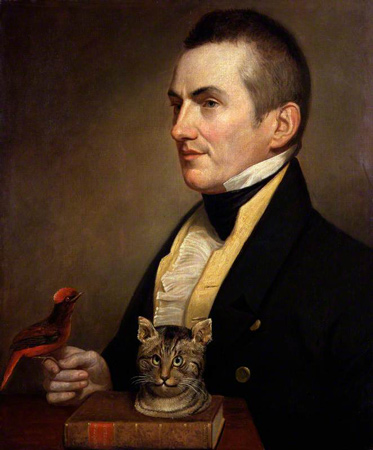In Peale’s later years, he expected that as a gentleman farmer he would give himself over to a life of art.
Gentleman Farmer
The museum a thriving concern, Peale, almost 70, decided he would quit active management—taking a generous stipend from museum revenues—and, as he noted in a letter to Jefferson in February 1809, “I begin already to be much occupied in preparing for my departure to those scenes of rural retirement after which my soul is painting.”[1]Ibid., February 6, 1176. Peale’s “painting” is a pun on the verb “to pant,” as in Psalm 42:1, “As the hart panteth after the water brooks, so panteth my soul after … Continue reading Purchasing over one hundred acres of rolling land in 1810,[2]The farm was located near Germantown, six miles northwest of old Philadelphia‘s center, on what is now Olney Avenue. The farmhouse and some of the land are now owned by LaSalle University. Peale expected that as a gentleman farmer he would give himself over to a life of art. He did paint more, but Peale, as energetic as ever, also poured himself into the agricultural and technological arts. Sellers writes that Peale was occupied with technological invention, projects including “plans for his textile manufacturing center, [and] a storm-resistant windmill that would harness the power of air for him and perhaps pump water for the entire city at a trifling cost.”[3]Sellers, Museum, 223.
These projects were typical of Peale’s experiments with ways to improve life and make profit. No one proved interested in pumping water for the city. The windmill itself blew down seven times before a spring mechanism was developed that relieved strain on the blades during storms. The textile mill was built, Peale needing to mortgage the farm to raise money for it. War with Britain, having cut off British imports, created an opportunity for domestic manufacturing. But the mill was not operational until 1816, after peace was declared, and the small mill could not compete with a flood of inexpensive imported textiles. Profits remained low. Peale experimented for years with making decay-proof false teeth, achieved success with his own set, and in 1826 tried seriously to go into the business of manufacturing them, but the cost of the materials was high and the labor was intensive—too much so for a man then 84 years old.
The farm itself was successful if not very profitable—or, more accurately, it was profitable, but the profits were consistently poured into new projects. Peale raised hay, wheat, corn, potatoes, turnips, apples and, on the advice of neighbors, he planted currants, used—despite Peale’s personal disapproval of alcoholic drinks—to make wine. The wine was popular among Philadelphia connoisseurs. It was, in Sellers’ words, “the most successful product of his farm, full of light and delight, wrought with distasteful conscientious care.”[4]Sellers, 364.
Peale’s Garden
Belfield Mansion
Garden fence at left
Drawing, from a letter by C.W. Peale, 22 July 1810. American Philosophical Society, Philadelphia.
Despite success with crops, Peale, always thinking big, wanted no less than to create an ideal rural paradise. A significant part of the vision was the creation of an extensive garden, with flowers and walkways, statues and views and inscriptions. The garden, writes Sellers, “was taking the place in [Peale’s] heart that the Museum had filled.”[5]Ibid., 366. A formal walk led from the house to a sundial bordered with flowers. From here the garden swept downward, through winding paths bordered by shrubs and flowers, with “glens, hills and woodland” enclosing the open southern exposure. “Under all this lay an elaborate system of drains, protecting it from the ravages of rain and melting snow, almost as great a work as those which the eye could see.”[6]Ibid., 366-67. The garden became an attraction, to the detriment of the farm. So many people visited the garden that on Sundays Peale eventually had to close the gates because the throngs were harming the fruit trees.
In the garden were allegorical figures, a fountain, and inscriptions, all designed to bring in “some moral sentiment to augment the utility.”[7]Peale quoted in Sellers, 367. Sentiment and utility for Peale invariably focused on nature and its wonders. In one of the several summer houses erected in the garden the one constructed in the “Chinese taste” and meant for contemplation featured this inscription:
Meditate on the Creation of worlds, which perform their evolutions in prescribed periods! on the changes and revolutions of the Globe, which we inhabit: on the wonderful variety of animals inhabiting the earth, the air and the waters: their immense number and diversity: their beauty and delicacy of structure: some immensely large, and others gradually descending into a minuteness almost eluding our sight, even when aided by the Microscope! all, have ample support:– Then let me ask myself, why am I here? Am I blessed with more profound reason than other Animals? If so, Let me be thankful: let me meditate on the past, on the present, and on the future.[8]Ibid., 368.
Beneficent nature was manifested at Belfield, but its master was gradually drawn back to his museum. Belfield was eventually sold in 1826 to pay off debts.
Inventor
To reduce the labor of carrying fresh milk from his cow pen to the spring house, Peale designed a spill-proof milk cart. He explained: “I got a large ceder Tub of an oval form made with a cover to it, a little below the top are 4 pegs to rest a strainer on, a wire [illegible] made to fit its place, a broad rim to run the wire through. to prevent the wire from rusting I varnished it. A frame to let the top move freely in, with pivots in opposite direction to those in the Tub, and thus it swings like the mariners compass. The carriage has 3 wheels, the hind wheels with a crooked axle tree to let the carriage be low. The strainer prevents the splashing of the milk from perpendicular jolts. The pivots of the Tub so as admit it to be tilted to pour into the pan set on the fore part of the Carriage, having a lip to the Tub to prevent the spilling of milk. The fore wheel with a swivel, and the tongue braces the axletree to turn the wheel to the right or left.”
Last Works of the Master
Charles Waterton (1824)
Charles Willson Peale
Oil on canvas, 20.2 x 24.1 in (51.4 x 51.4 cm). National Portrait Gallery, London.
Charles Waterton (1782–1865) is credited with setting up England’s first conservation area. Of Waterton, David Attenborough said he was, “one of the first people anywhere to recognise not only that the natural world was of great importance but that it needed protection as humanity made more and more demands on it.”[9]“Sir David Attenborough will open city centre’s new museum,” 28 July 2013 Wayback Machine archived at … Continue reading
As we have seen, Peale was closely connected with the cultural, intellectual, political, and scientific worlds of his time. The average American, however, probably first hears Charles Willson Peale‘s name in connection with his paintings. He was a master craftsman, always striving to improve his product, yet always creating works that were recognizably his own.[10]For a comprehensive list of Peale’s’ works, see Charles Coleman Sellers, “Portraits and Miniatures by Charles Willson Peale,” Transactions of the American Philosophical … Continue reading
During his long life, Peale made hundreds of paintings, a remarkable output, since there were years when he painted almost nothing. At the age of eighty-one he painted perhaps his greatest work, the famous portrait of himself holding up a curtain to display behind it the long room of his Museum. It is, as Sellers notes, a visual autobiography, the painter’s palette resting on a table while the museum proprietor invites the world to investigate the wonders of nature. It is a masterpiece of light and shadow.
Peale painted other pictures in his last years, such as a portrait (1824) of the English naturalist Charles Waterton. The grandest artistic project was the construction of nine transparencies to hang in front of the Museum windows in the State House in honor of the 1824 visit of General Lafayette. In Sellers’ words,
The central panel of the nine featured a white bust of Lafayette, wearing a civic crown and garlanded with flowers, the American eagle screaming overhead, and around it all a glory of French and American flags, cannon, spears, muskets, the whole panoply of martial triumph which the young Lafayette had been so eager to achieve, unmarred by any trace of Peale the pacifist.[11]Sellers, 416.
Heavy with triumphant nostalgia, Lafayette’s visit was for many a celebration of the already-mythic struggle for independence, embodied by Lafayette; even Peale succumbed to—or at least chose to indulge in—the patriotic fervor.
Late in 1826, Peale journeyed to New York to court a potential fourth wife. On the way back to Philadelphia, his steamboat ran aground a mile from the landing. “The old man was obliged to walk, carrying his heavy horsehair trunk, as well as cloak and umbrella, over a rough path, through dark and cold, and would have fallen exhausted had not another passenger helped him a little of the way.”[12]Sellers, 431. Too much even for hardy Charles Willson, the walk strained his heart; he died a few months later just short of his eight-sixth birthday.
All who met him admired his energy and enthusiasm, which, despite personal tragedies, scarcely flagged throughout his long life. Practical, intent on learning about the world and how things were done, believing in bettering the human condition and the shining destiny of the new United States, Charles Willson Peale left an indelible mark on America. Our national heritage is the richer for it.
Notes
| ↑1 | Ibid., February 6, 1176. Peale’s “painting” is a pun on the verb “to pant,” as in Psalm 42:1, “As the hart panteth after the water brooks, so panteth my soul after thee, O God.” |
|---|---|
| ↑2 | The farm was located near Germantown, six miles northwest of old Philadelphia‘s center, on what is now Olney Avenue. The farmhouse and some of the land are now owned by LaSalle University. |
| ↑3 | Sellers, Museum, 223. |
| ↑4 | Sellers, 364. |
| ↑5 | Ibid., 366. |
| ↑6 | Ibid., 366-67. |
| ↑7 | Peale quoted in Sellers, 367. |
| ↑8 | Ibid., 368. |
| ↑9 | “Sir David Attenborough will open city centre’s new museum,” 28 July 2013 Wayback Machine archived at http://www.wakefieldexpress.co.uk/news/local-news/sir-david-attenborough-will-open-city-centre-s-new-museum-1-5439242. |
| ↑10 | For a comprehensive list of Peale’s’ works, see Charles Coleman Sellers, “Portraits and Miniatures by Charles Willson Peale,” Transactions of the American Philosophical Society, n.s. vol. 41, pt. 1, June 1952, and Sellers, “Charles Willson Peale with Patron and Populace: A Supplement to Portraits and Miniatures by Charles Willson Peale with a Survey of His Work in Other Genres,” also in Transactions, n.s., vol. 59, pt. 3, May 1969. |
| ↑11 | Sellers, 416. |
| ↑12 | Sellers, 431. |




